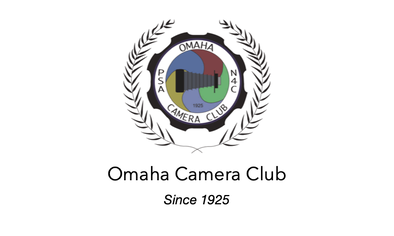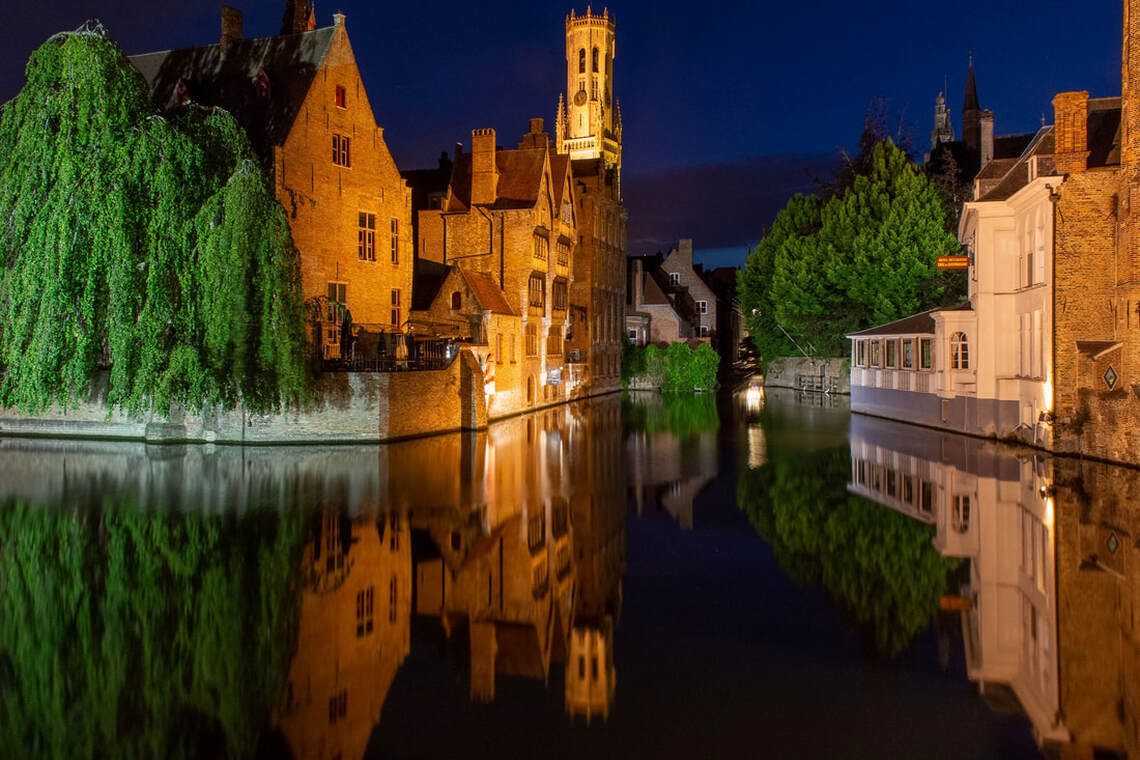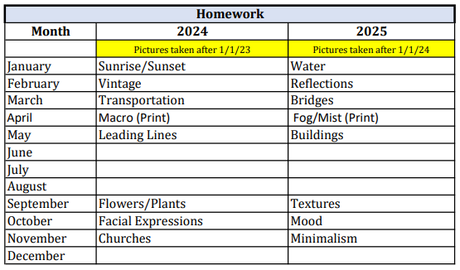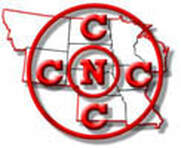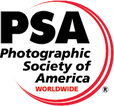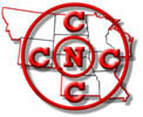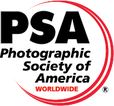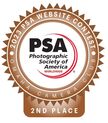Competition: Introduction
Our members challenge themselves by submitting photographs to compete against other members on both a local and regional basis. Our local club competition events are held most months as described below. Additionally, our club is a member of the North Central Camera Club Council (N4C), an association of 37 clubs in an 11-state area. Like our club, N4C holds competition events most months and a full description is provided below.
- Each year our club holds Digital Contests in the months of February, March, May, September, October and November.
- We hold a Print Contest in the month of April.
- See OCC Handbook for complete rules
Competition: Description of Categories
The following subject category definitions are presented as a guide to persons entering the monthly contests so that all entries may be judged fairly and equally. To some extent, their interpretation is subjective, and all judges have some personal biases. It is our intent to minimize these differences. These definitions are as clear and precise as we are able to state them, though it is not possible to cover all eventualities and answer all questions. Generally, those entries that conform most closely to the subject definitions have the greatest chance of success in the contests.
Altered Reality
Altered Reality photography is an opportunity for those who dare to explore the experimental and creative forms of photographic expression. These will include, but not be limited to derived images, ultra-high contrast, black light, bas-relief, solarization, multi-images, trick lenses and filters, and other ways to alter the image to produce a new abstract effect. Just about anything goes. The important thing is the result, not the means to create it. This area of photography bridges between photographic realism and creative art. It is very difficult to judge and there are literally no rules to follow. Generally, concentration on form and color rather than detail in the image will help you succeed.
Homework
|
The Homework category refers to the monthly subjects determined by the OCC members during a business meeting each November. One subject is listed for each month of competition. Subjects are selected for 12 months at a time and allow members a minimum of 12 months to capture. For instance: whatever the current month and year you are submitting a homework photo for, you can use a photo that was taken anytime from the preceding year up to the present day. If you were submitting a photo today it could have been taken as early as January 1 of the preceding year.
|
Our current Homework selections are:
|
journalism
Journalism Photography or Photojournalism means simply the telling of a story by the use of a picture, or a sequence of related separate pictures arranged for presentation as a single entry. The type of photograph that one sees in the newspaper or magazines that depicts some event or activity is what is meant. The caption is important, but the best journalistic photographs tell their own stories and don’t always need a caption. A good picture is, after all, worth more than a thousand words. An element of human interest is important and virtually essential for pictures to succeed in competition. Interest is paramount, but good composition and technique will often make the difference that decides the winners.
Special note for Nature Images and Journalism Images
The only digital editing that can be allowed must fit with the N4C definition for acceptable Journalism or Nature images. In the interest of credibility, photographs which misrepresent the truth, such as manipulation to alter the subject matter, or situations which are set up for the purpose of photography, are unacceptable. No elements may be moved, cloned, added, deleted, rearranged, combined or changed in any way that affects the integrity of the image content. No manipulation or modification is permitted except resizing, cropping, selective lightening or darkening, and restoration of original color of the scene. No special effect filters can be added or applied, and any sharpening must appear natural.
The only digital editing that can be allowed must fit with the N4C definition for acceptable Journalism or Nature images. In the interest of credibility, photographs which misrepresent the truth, such as manipulation to alter the subject matter, or situations which are set up for the purpose of photography, are unacceptable. No elements may be moved, cloned, added, deleted, rearranged, combined or changed in any way that affects the integrity of the image content. No manipulation or modification is permitted except resizing, cropping, selective lightening or darkening, and restoration of original color of the scene. No special effect filters can be added or applied, and any sharpening must appear natural.
nature
- Nature photography is simply the recording of our natural world by some photographic means. Included are all branches of nature except Archeology and Anthropology.
- No photograph is worth the distress or injury to any wild creature.
- Nature photographs may be either black & white or color.
- The hand of man shall not be present in any nature entry except where wild animals have adapted to the built environment (e.g., fence posts and other man-made objects freely adapted for use by wild creatures).
- Banding or tagging on nature subjects is acceptable. Photographs at bird feeders are not acceptable if any part of a man-made feeder is shown in the photograph.
- Photographs taken in zoos, animal farms or game farms are acceptable as long as the setting remains natural, and the hand of man is not visible.
- Domestic animals and pets are not acceptable and should be entered in other categories.
- Adjustments must look natural. The use of HDR, exposure blending, focus stacking, stitching, and related techniques that combine more than one image is acceptable, provided the resulting image is natural in appearance.
Special note for Nature Images and Journalism Images
The only digital editing that can be allowed must fit with the N4C definition for acceptable Journalism or Nature images. In the interest of credibility, photographs which misrepresent the truth, such as manipulation to alter the subject matter, or situations which are set up for the purpose of photography, are unacceptable. No elements may be moved, cloned, added, deleted, rearranged, combined or changed in any way that affects the integrity of the image content. No manipulation or modification is permitted except resizing, cropping, selective lightening or darkening, and restoration of original color of the scene. No special effect filters can be added or applied, and any sharpening must appear natural.
The only digital editing that can be allowed must fit with the N4C definition for acceptable Journalism or Nature images. In the interest of credibility, photographs which misrepresent the truth, such as manipulation to alter the subject matter, or situations which are set up for the purpose of photography, are unacceptable. No elements may be moved, cloned, added, deleted, rearranged, combined or changed in any way that affects the integrity of the image content. No manipulation or modification is permitted except resizing, cropping, selective lightening or darkening, and restoration of original color of the scene. No special effect filters can be added or applied, and any sharpening must appear natural.
pictorial
In pictorial photography we are concerned with the artistic quality of the presentation of the subject rather than with the subject itself. Literally, all subjects qualify, but since “Interest” accounts for one-third of the score, subjects that catch the viewer’s eye will have an advantage. The judges will be seeking answers to the question, “Did the photographer simply record the subject, or did he/she through the photographic process enhance the viewer’s interest in the subject?” Pictorialism may be accomplished by meticulous photographic technique, proper presentation, careful composition, or most likely all of these factors.
travel
Travel implies going to some place other than one’s customary environment, and photo-travel photography suggests the photographic depiction of that new environment or the means used to get there. There is no definition of how far away that environment must be to qualify as “travel” or how different that new environment must be. However, the judges will generally award prizes to those photographs that depict more exotic and unfamiliar places, even though such places are “home” to someone. Good photographic technique and particularly the ability to convey the feeling and flavor of the place visited will help you be a winner. Try to emphasize the character that makes the place unique from other places. Be sure to state the state or nation in the title where the picture was made on the slide or print.
Black and white
B&W Category Definition
The Monochrome category is similar in character to Pictorial, except that the category is for black & white images. Images are limited to monochromatic hues or shades of gray, although filters may be applied to give a hue or tint. Different photographic processes and toners give a different hue to a black & white photograph, for example, selenium, sepia, and split toning (duo-toning). No fraction of the image shall be given a special color treatment. Black & White prints and digital images may be created from:
The use of HDR, exposure blending, focus stacking, stitching, and related techniques that combine more than one image is acceptable.
The Monochrome category is similar in character to Pictorial, except that the category is for black & white images. Images are limited to monochromatic hues or shades of gray, although filters may be applied to give a hue or tint. Different photographic processes and toners give a different hue to a black & white photograph, for example, selenium, sepia, and split toning (duo-toning). No fraction of the image shall be given a special color treatment. Black & White prints and digital images may be created from:
- black & white film,
- digital black & white captures, or
- digital color images converted to black & white.
The use of HDR, exposure blending, focus stacking, stitching, and related techniques that combine more than one image is acceptable.
Omaha Camera Club Competition Rules
Digital Competition
digital image submission guidelines
Please refer to the OCC Handbook for Submission Guidelines.
resizing photos
- If you have questions on how to resize your photo in order to submit for competition, you might refer to one of the following videos: (Note: some of the videos are a bit dated but they can give you an idea of the process).
- Exporting from Lightroom Classic: https://youtu.be/vqk6Qbb6F-E
- Lightroom Export Presets: https://youtu.be/mMB1Nbopqwo
- Exporting from Photoshop: https://youtu.be/BEqmSllYtp4
how to enter photos for competition using pollunit
Refer to OCC Handbook for illustrated instructions.
how digital judging is conducted
Print Competition
print submission guidelines
- Print competition is held in the spring, usually in April. The competition is judged by an outside source. (See OCC Handbook under “Guidelines for Print Competition”).
print competition categories
Print Competition Categories
- A = Altered Reality
- B = Black and White
- H = Homework (a different subject each month)
- J = Journalism
- P = Pictorial
- N = Nature
- T = Travel
How Print judging is conducted
- An outside judge will score between 1 and 10 points for each image based upon Technique, Interest/Impact and Composition (TIC). Fractions of numbers are allowed for scoring. If the Judge determines that an entry does not satisfy the category, the Judge will score DQ.
- Technique: Focus, lighting, color rendition, exposure, print quality.
- Interest: Originality, imagination, interpretation, subject, impact, mood, humor, etc.
- Composition: Arrangement of all elements within the picture area so the subject matter is presented as a harmonious, well- balanced photograph.
Show & Tell F.A.Q.
What is show and tell?
“Show and Tell” is an opportunity to share some of your personal photographs with fellow members. It may be of a recent trip you took, an event you attended, a special project you are working on or just some family pictures of a celebration.
Photos can be shown by the member with or without the request for feedback/critique. It is an opportunity for members to invite feedback and discussion of their photos towards a goal of improvement.
Photos can be shown by the member with or without the request for feedback/critique. It is an opportunity for members to invite feedback and discussion of their photos towards a goal of improvement.
how many photos should i submit?
Up to 10 if you are simply sharing, but only 2 or 3 if you would like specific feedback regarding them. Remember that we do have some time constraints and other members will want to share their photos during our meeting.
how should i submit photos?
New Method: Each month for Show and Tell, you will receive an email with a link to PollUnit to upload your images. Simply follow the instructions in the email as well as on PollUnit to upload your images.
What File Type should i use
JPG is highly preferred. If you’re concerned about data loss, try PNG.
Does file size matter
File size can be up to 50MB but generally, files around 3mb to 4mb work best.
what if i want to do something different from above?
Go for it. Your participation is most important.
I just take pictures and all this geek stuff confuses me...what should I do?
If you are confused you can reach out through our Facebook page, or send an email to the membership or contact our President at [email protected]
Pollunit instructions for show and tell
Please refer to the OCC Handbook for PollUnit instructions.
Note: Please don't confuse "Show & Tell" guidelines with the Club competition or N4C rules!
North Central Camera Club Council (N4C) Competition
N4C competition is competition among 37 clubs in a 11-state area. While their rules for submission are close to our club’s, you should refer to the council’s specific guidelines at http://n4c.us/N4C_Contest_Rules_2023-2024.pdf
Normally each member may submit one entry per category with a maximum of six entries per member AND a club quota of eight maximum within a category. When our club is asked to judge a category for N4C (ie. Nature), then we are not allowed to submit entries for that category that month. This is made up in the following month when our club is allowed to double our Nature entries. When we have more entries from members than are allowed, we will have a runoff within the club to determine which will be submitted to N4C.
All entries for N4C should be submitted to Nikki McDonald at [email protected] and are due by the first of the month.
While N4C hosts both digital and print competition, our club currently only participates in the digital competition.
Normally each member may submit one entry per category with a maximum of six entries per member AND a club quota of eight maximum within a category. When our club is asked to judge a category for N4C (ie. Nature), then we are not allowed to submit entries for that category that month. This is made up in the following month when our club is allowed to double our Nature entries. When we have more entries from members than are allowed, we will have a runoff within the club to determine which will be submitted to N4C.
All entries for N4C should be submitted to Nikki McDonald at [email protected] and are due by the first of the month.
While N4C hosts both digital and print competition, our club currently only participates in the digital competition.
Photographic Society of America (PSA) Competition
Our club is an affiliate of Photographic Society of America. The Photographic Society of America (PSA), founded in 1934, is a world-wide organization providing abundant resources for photographers, from the novice to the professional. PSA offers on-line learning, webinars, study groups, competitions, mentors and consultants. Membership is in over 80 countries, 5,000 members, 460 Camera Clubs and 12 Chapters across the United States.
You need to join PSA as an individual in order to access their member services and to enter competitions. Please go to https://psa-photo.org for more information.
You need to join PSA as an individual in order to access their member services and to enter competitions. Please go to https://psa-photo.org for more information.
